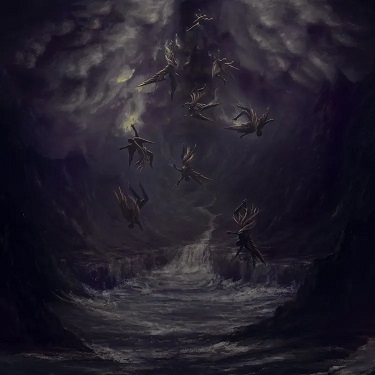Those who have deep knowledge of Greek black metal, are aware of the existence of a new wave of underground restless forces, born from the womb of domestic and foreign tradition. Among them, Thy Darkened Shade are a peculiar case of inspiration and creativity. You see, Semjaza and The A don’t approach art according to any kind of inflicted trends, or sales volumes. Their priority is the art itself; they follow vibes that emerge from the subconscious and release something only if they feel it’s needed. Otherwise, their creation remains hidden.
Albeit forming in the abyss in 1999, it wasn’t until thirteen years later that TDS commenced their philosophic, anti-cosmic journey in discography, via the devilish black ‘n thrash of “Eternvs Mos, Nex Ritvs”. Soon afterwards, the extraordinary “Liber Lvcifer I: Khem Sedjet” revealed triumphantly the band’s potential; although based on their raw, rough debut, the out-of-this-world complex riffing and the inconceivable ways of structuring Luciferian chaos through order, left a monumental dark jewel that still shines. The Promethean black flame had risen, but it wasn’t meant to wither.
Another nine years passed, with some split releases occurring in the meantime. The forces that would generate the second chapter of “Liber Lvcifer” trilogy were working tirelessly, meticulously, patiently, lurking in Semjaza’s mind, away from our reality. Eventually, earlier that year, “Liber Lvcifer II: Mahapralaya” emerged, and it surpassed what we already had listened to.
First things first, the artwork by Vamperess Imperium, a band’s long-time collaborator, is a dark masterpiece that foretells what we’ll hear. The Fall of Lucifer and his demons (or the Fall of Man?), depicted in a way that resembles classical paintings, makes you realize, without listening to a single note, that you shouldn’t expect a faint, reassuring ray of light to offer you false, self-suggestive hopes. Later, you’ll confirm that the content is a deterministic declaration of damnation, forbidding even the slightest shading of redemption.
In “Mahapralaya” TDS’s vision evolves, and mastery in composition reach levels beyond perception. Their distinctive style, previously introduced in “Khem Sedjet”, is embodied in a much deeper, sentimentally and musically, mosaic. Music becomes more theatrical, abolishing space and time. A transcendental experience isolates you from our existential plane; “…Δαίμων του Ερέβους, Σατανάς Αιώνιος…” the epic choral vocals comment in the introductory, spellbinding “Luciftias”, and the journey to the abyss has begun, where the Bringer of Light dwells.
“Mahapralaya”, analogous to a drear, horrific, operatic act, is a masterpiece of skillful performance and ingenious development of ideas. Songs are structured wisely, methodically, patiently, with a variety of technical riffs and melodic patterns, like in the hellish “Sacrosanct Pyre”. The song, occurring without warning after the short introduction, signifies the path that the band follow and unfolds the Erebus. The succession of attitudes is -initially- hard to follow but rewarding later on.
The use of vocals sends the album to another level. Semjaza and The A collaborate ideally, adjusting themselves to every condition. Whole dialogues foreshadow the destructive power of darkness in aggressive parts that require vocalist’s intensity and dedication to tradition, and atmospheric moments, where the chorus, clean approach form a macabre theater of unholiness. Watch how this works, while you descend “Into Eerie Catacombs”; recites caress ears and soul, emphasizing on an ungodly theme, amidst roughness and abrupt turns.
The band’s melodic façade is more featured as you approach the heights (or depths?) of the next two tracks. The impressive “Sathanastasis” reveals a horror of something primordial approaching; “Ascending of Satan…” the vocalist comments, while bell chimes and a sick melody declare the coming of darkness. You cannot but admire the majesty of the song. Now, escape from TDS’s claws is impossible; since you’ve reached that far, the only way is reaching the end. However, there are more chapters of excellence ahead; the staggering melody of “Qelippot Epiphany” builds a dramaturgy without the variations that you’ve met so far. Here, we discern the band’s Greek origins (Kawir and Varathron have meddled repeatedly with such epic themes).
Hereupon, more aggressive, raw instincts emerge. The dyad of “Acausal Current of Thanatos” and “Veneration for the Fireborn King” are relentlessly violent with frantic, demonical sharp riffing and drumming that clearly verify the band’s intentions. The unmerciful attack continues in “Noxious Witchery of the Titans”, where TDS combine epic and horror insolubly, in a song easily comparable to Icelandic bands’ inhuman moments (here, I made a subconscious reference to Misþyrming’s “Með hamri”). After the hammering riffage, the transition to an atmospheric choir and a nightmarish sonic avalanche shock you to the core; the way that the various themes are unfolded is indeed a “seminar”. The ending in the melodic, slow “Typhonian Temple” is an unexpected and overwhelming contrast. Vocals enchant and awe through their plain majesty; “Χαίρε Τυφών, Χαίρε Έχιδνα…” fills space and mind, and the circle closes.
Listening to “Mahapralaya” is a unique experience, enhanced by V. Santura’s excellent production. He’s succeeded in pointing out the band’s arcane character and primordial sound, despite the admittedly difficult material he had in his hands. Whether in straightforward or more progressive structures, you can hear everything clearly, without reductions in rawness, taking pleasure in the appealingly warm sound. Vocals are properly highlighted, so that they have the necessary prominence, while bass is always audible (you’ll realize that it’s an outstanding oddity and entity, governing the totality of “Mahapralaya”).
The album is so shocking and peculiar, that I felt the need to write some words for each one of the songs (I don’t do this very often), no matter my inability to express, even to a satisfying extent, what really happens in there. Humbly, I consider it to be a landmark for the Greek scene already; therefore, some written comments are the least I can do.
Sooner or later, you’ll find out that you cannot abstain from “Mahapralaya” for a long time. Its appealing power is catalytic; unavoidably, you’ll seek further submersions and explorations in its forlorn, unlit catacombs, and each time, you’ll discover a new element, a detail that you previously missed. That’s the gripping strength of the album; since it reveals its splendor, it calls you back.
“Mahapralaya” is a paradigm of how a thorough study of apocryphism and philosophy can be a prolific ground for inspiration and creation, impressing the listener in terms of dedication, inspiration, structure of ideas, and execution. TDS were a force in the Greek underground to be reckoned with; we knew that they were destined to make remarkable things happen. Now, it’s about time more eager learners become acquainted with them. As for the third part of the trilogy, I prefer not to think about it…
♦ 10/10
Alex Nikolaidis
https://www.youtube.com/watch?v=I84F6RESEGA

